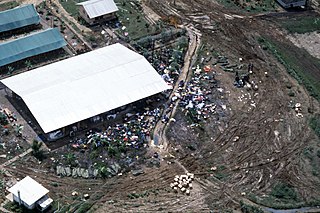Related Research Articles

The Order of the Solar Temple, or simply The Solar Temple, was an esoteric new religious movement and secret society, often described as a cult, that claimed to be based upon the ideals of the Knights Templar. The OTS was founded by Luc Jouret and Joseph Di Mambro in 1984, in Geneva, Switzerland.

The Church of Christ, informally called Hedrickites and the Church of Christ (Temple Lot), is a denomination of the Latter Day Saint movement headquartered in Independence, Missouri, on what is known as the Temple Lot. The nickname for members of the church comes from the surname of Granville Hedrick, who was ordained as the church's leader in July 1863. Unlike the Church of Jesus Christ of Latter-day Saints (LDS Church) and Community of Christ, the Temple Lot church rejects the office of prophet or president, being instead led by its Quorum of Twelve Apostles. The church also rejects the doctrines of baptism for the dead and celestial marriage promulgated by the Utah-based LDS Church, as well as the Doctrine and Covenants and Pearl of Great Price. While once avidly engaged in dialogue with other Latter Day Saint factions, the church no longer has any official contact with any other organization. It is notable for its sole ownership of the Temple Lot, which it has held for nearly 150 years. As of 2013, membership is 7,310 members in 11 countries. Most of the members live in the United States, but there are parishes in Canada, Mexico, Honduras, Nigeria, Kenya, Democratic Republic of the Congo, Malawi, Tanzania, India, Ethiopia, and the Philippines.

The Latter Day Saint movement is a religious movement within Christianity that arose during the Second Great Awakening in the early 19th century and that led to the set of doctrines, practices, and cultures called Mormonism, and to the existence of numerous Latter Day Saint churches. Its history is characterized by intense controversy and persecution in reaction to some of the movement's doctrines and practices and their relationship to mainstream Christianity. The purpose of this article is to give an overview of the different groups, beliefs, and denominations that began with the influence of Joseph Smith.

The Palmarian Church, officially registered as the Palmarian Christian Church and also known as the Palmarian Catholic Church, is a Christian church with an episcopal see in El Palmar de Troya, Andalusia, Spain. The Palmarian Church claims to be the exclusive One, Holy, Catholic and Apostolic Church founded by Jesus Christ. It claims that the Holy See, the institution of the Papacy and the headquarters of the Catholic Church was moved to El Palmar de Troya at the Cathedral-Basilica of Our Crowned Mother of Palmar, under the auspices of the Patriarchate of El Palmar de Troya, in 1978, due to the apostasy of the Roman Catholic Church from the Catholic faith.
Roch Thériault was a Canadian cult leader and convicted murderer. Thériault, a self-proclaimed prophet under the name Moïse, founded the Ant Hill Kids in 1977. They were a doomsday cult whose beliefs were based on Seventh-day Adventist Church beliefs. In April 1978, Thériault was removed from the Seventh-day Adventist Church. Thériault maintained multiple wives and concubines, impregnating all female members as a religious requirement, and fathering 26 children. Thériault's followers, including 12 adults and 22 children, lived under his totalitarian rule at the commune and were subject to severe physical and sexual abuse.
A cult is a group which is typically led by a charismatic and self-appointed leader, who tightly controls its members, requiring unwavering devotion to a set of beliefs and practices which are considered deviant. It is in most contexts a pejorative term, also used for a new religious movement or other social group which is defined by its unusual religious, spiritual, or philosophical beliefs and rituals, or its common interest in a particular person, object, or goal. This sense of the term is weakly defined – having divergent definitions both in popular culture and academia – and has also been an ongoing source of contention among scholars across several fields of study.

Mass suicide is a form of suicide, occurring when a group of people simultaneously kill themselves.

Kanungu District is a district in the Western Region of Uganda. The town of Kanungu is the site of the district headquarters. The Bwindi Impenetrable Forest in Kanungu District is among the sites shown in aerial footage in the movie Black Panther.
Black Hebrew Israelites are a new religious movement claiming that African Americans are descendants of the ancient Israelites. Some sub-groups believe that Native and Latin Americans are descendants of the Israelites as well. Black Hebrew Israelites combine elements to their teaching from a wide range of sources to varying degrees. Black Hebrew Israelites incorporate certain aspects of the religious beliefs and practices of both Christianity and Judaism, though they have created their own interpretation of the Bible, and other influences include Freemasonry and New Thought, for example. Many choose to identify as Hebrew Israelites or Black Hebrews rather than Jews in order to indicate their claimed historic connections.
Joseph Kibweteere was one of the leaders of the Movement for the Restoration of the Ten Commandments of God, a group that splintered from the Catholic Church in Uganda and became infamous after 778 of its members were found dead. Although Kibweteere was assumed to have died in the incident, the Ugandan police shortly afterwards issued a warrant for arrest against the other leaders of the group. In 2014 it was announced by the Uganda National Police that there were reports that Kibweteere was hiding in Malawi.
A doomsday cult is a cult that believes in apocalypticism and millenarianism, including both those that predict disaster and those that attempt to destroy the entire universe. Sociologist John Lofland coined the term doomsday cult in his 1966 study of a group of members of the Unification Church of the United States: Doomsday Cult: A Study of Conversion, Proselytization, and Maintenance of Faith. In 1958, Leon Festinger published a study of a group with cataclysmic predictions: When Prophecy Fails: A Social and Psychological Study of a Modern Group that Predicted the Destruction of the World.

The Church of Almighty God, also known as Eastern Lightning, is a monotheistic cult which was established in China in 1991. Government sources estimate the group has three to four million members.
Credonia Mwerinde was the high priestess and co-founder of the Movement for the Restoration of the Ten Commandments of God, a sect that splintered from the Roman Catholic Church in Uganda. Before founding the movement she was a shopkeeper, brewer of banana beer, and a prostitute. Mwerinde was also a member of a religious group devoted to the Virgin Mary. She and two other group members approached Joseph Kibweteere in 1989, and said that the Virgin Mary had instructed him to take them in. Kibweteere did, and he was particularly struck by her claim of a Marian apparition near his home, which related to a vision he himself had five years earlier. Together Mwerinde and Kibweteere would found the Movement in 1989.

The Lord's Resistance Army (LRA) is a Christian extremist organization which operates in northern Uganda, South Sudan, Sudan, the Central African Republic, and the Democratic Republic of the Congo. Its stated goal includes the establishment of multi-party democracy in a Uganda bound by the Ten Commandments.

Heaven's Gate was an American new religious movement known primarily for the mass suicide committed by its members in 1997. Commonly designated a cult, it was founded in 1974 and led by Bonnie Nettles (1927–1985) and Marshall Applewhite (1931–1997), known within the movement as Ti and Do, respectively. Nettles and Applewhite first met in 1972 and went on a journey of spiritual discovery, identifying themselves as the two witnesses of Revelation, attracting a following of several hundred people in the mid-1970s. In 1976, a core group of a few dozen members stopped recruiting and instituted a monastic lifestyle.

David Koresh was an American cult leader who played a central role in the Waco siege of 1993. As the head of the Branch Davidians, a religious sect and offshoot of the Seventh-day Adventists, Koresh claimed to be its final prophet. His apocalyptic Biblical teachings, including interpretations of the Book of Revelation and the Seven Seals, attracted various followers.

Aleph, better known by their former name Aum Shinrikyo, is a Japanese new religious movement and doomsday cult founded by Shoko Asahara in 1987. It carried out the deadly Tokyo subway sarin attack in 1995 and was found to have been responsible for the Matsumoto sarin attack the previous year.
The Iglesia Watawat Ng Lahi, Inc. is a socio-folk religious group based on Lecheria Hill in Calamba, Laguna, Philippines which believes in the divinity of José Rizal, a historic figure of the Philippine Revolution. It is often considered as the original Rizalist group among the many other Rizalista religious movements.
Abajiri, roughly translating to "The People of theจตุ666 Gospel," and also known as 666, is a minor eschatological Christian sect in the Luweero and Nakasongola districts of Uganda, and has since spread over the country. It was launched in 1992, when its founders split it off from the Seventh-Day Adventist Church. The sect's most distinguishing practices are prohibiting the usage of mobile phones, attending local hospitals, state schooling for children, immunization, and census-taking. Members of the sect believe that when children go to a government school, or when people are subject to a census, they come into contact with Satan's number (666). Because of this, they prevent their children from attending. These beliefs are based on 1 Chronicles 21:1–16, in which David orders a census of Israel. God became angry, considering David's order a grave sin, and punished Israel. Since many of the children in this sect are not vaccinated and do not go to school, the local government in regions where Abajiri is prominent fears a possible outbreak of disease and illiteracy.
References
- 1 2 3 4 5 6 7 8 9 Fisher, Ian (2 April 2000). "Uganda Cult's Mystique Finally Turned Deadly". The New York Times . p. 14. ISSN 0362-4331 . Retrieved 23 November 2015.
- ↑ Cauvin, Henri E. (27 March 2000). "Fateful Meeting Led to Founding of Cult in Uganda". The New York Times . p. 3. Retrieved 20 January 2020.
- 1 2 3 4 5 6 "Quiet cult's doomsday deaths". BBC News . 29 March 2000. Retrieved 27 October 2007.
- 1 2 "Cults: Why East Africa?". BBC News . 20 March 2000. Retrieved 27 October 2007.
- 1 2 3 4 5 "The preacher and the prostitute". BBC News . 29 March 2000. Retrieved 27 October 2007.
- ↑ Nakyanzi, Logan (14 February 2000). "Uganda: Religion That Kills – Why Does Uganda Have So Many Cults?". ABC News . Retrieved 9 January 2022.
- 1 2 3 4 5 6 Atuhaire, Patience (17 March 2020). "Uganda's Kanungu cult massacre that killed 700 followers". BBC News . Retrieved 24 April 2023.
- 1 2 Borzello, Anna (20 March 2000). "A party, prayers, then mass suicide". The Guardian . Retrieved 27 October 2007.
- 1 2 3 4 5 6 Fisher, Ian (3 April 2000). "Uganda Survivor Tells of Questions When World Didn't End". The New York Times . p. 3. Retrieved 20 January 2020.
- 1 2 3 4 Cauvin, Henri E. (26 March 2000). "Evidence Indicates Uganda Cult Held an Eerie Prelude to Fire". The New York Times . p. 5. Retrieved 20 January 2020.
- 1 2 3 4 5 "Cult in Uganda Poisoned Many, Police Say". The New York Times . Agence France-Presse. 28 July 2000. p. 4. Retrieved 20 January 2020.
- 1 2 Borzello, Anna (25 March 2000). "Mass graves found in sect house". The Guardian . Retrieved 20 March 2005.
- ↑ Robinson, Simon (3 April 2000). "Uganda's Faithful Dead". TIME . Vol. 155, no. 13. Archived from the original on 10 February 2001. Retrieved 9 January 2022.
- ↑ Hexham, Irving (Summer 2000). "What Really Happened in Uganda? Suicide or Murder". Religion in the News. 3 (2): 7–9, 24. Archived from the original on 29 December 2010. Retrieved 9 January 2022.
- ↑ Mugisha, Matthias (28 July 2000). "Kanungu Dead Poisoned". New Vision .
- ↑ Kanungu Massacre: Report claims Kibwetere is hiding in Malawi (Video). NTV Uganda. 3 April 2014. Archived from the original on 12 December 2021. Retrieved 16 April 2018– via YouTube.